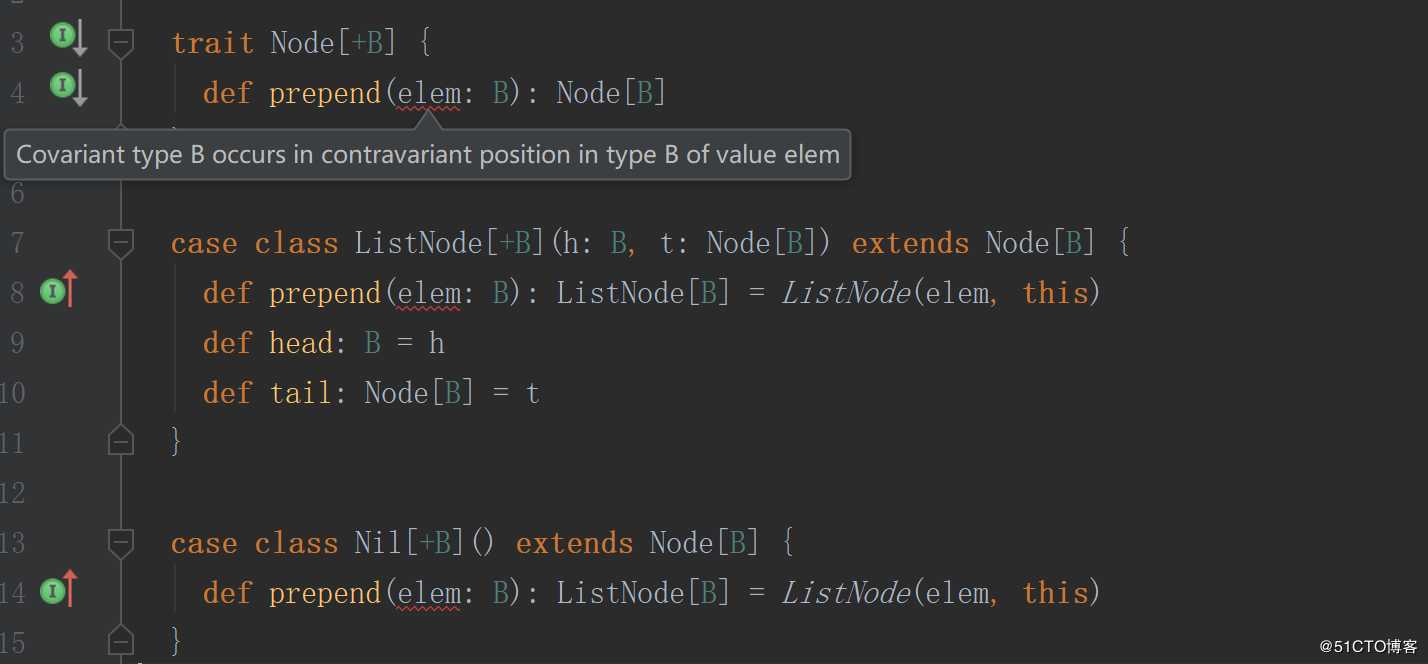标签:行操作 mamicode src printer 界定 分享 没有 ack 泛型
好程序员大数据学习路线分享Scala系列之泛型,带有一个或多个类型参数的类是泛型的。泛型类的定义:
//带有类型参数A的类定义
class Stack[A] {
private var elements: List[A] = Nil
//泛型方法
def push(x: A) { elements = x :: elements }
def peek: A = elements.head
def pop(): A = {
val currentTop = peek
elements = elements.tail
currentTop
}
}
泛型类的使用,用具体的类型代替类型参数A。
val stack = new Stack[Int]
stack.push(1)
stack.push(2)
println(stack.pop) // prints 2
println(stack.pop) // prints 1
1.协变
定义一个类型List[+A],如果A是协变的,意思是:对类型A和B,A是B的子类型,那么List[A]是List[B]的子类型。
abstract class Animal {
def name: String
}
case class Cat(name: String) extends Animal
case class Dog(name: String) extends Animal
Scala标准库有一个泛型类sealed abstract class List[+A],因为其中的类型参数是协变的,那么下面的程序调用时成功的。
object CovarianceTest extends App {
//定义参数类型List[Animal]
def printAnimalNames(animals: List[Animal]): Unit = {
animals.foreach { animal =>
println(animal.name)
}
}
val cats: List[Cat] = List(Cat("Whiskers"), Cat("Tom"))
val dogs: List[Dog] = List(Dog("Fido"), Dog("Rex"))
//传入参数类型为List[Cat]
printAnimalNames(cats)
// Whiskers
// Tom
//传入参数类型为List[Dog]
printAnimalNames(dogs)
// Fido
// Rex
}
2.逆变
定义一个类型Writer[-A],如果A是逆变的,意思是:对类型A和B,A是B的子类型,那么Writer[B]是Writer[A]的子类型。
abstract class Animal {
def name: String
}
case class Cat(name: String) extends Animal
case class Dog(name: String) extends Animal
定义对应上述类进行操作的打印信息类
abstract class Printer[-A] {
def print(value: A): Unit
}
class AnimalPrinter extends Printer[Animal] {
def print(animal: Animal): Unit =
println("The animal‘s name is: " + animal.name)
}
class CatPrinter extends Printer[Cat] {
def print(cat: Cat): Unit =
println("The cat‘s name is: " + cat.name)
}
逆变的测试
object ContravarianceTest extends App {
val myCat: Cat = Cat("Boots")
//定义参数类型为Printer[Cat]
def printMyCat(printer: Printer[Cat]): Unit = {
printer.print(myCat)
}
val catPrinter: Printer[Cat] = new CatPrinter
val animalPrinter: Printer[Animal] = new AnimalPrinter
printMyCat(catPrinter)
//可以传入参数类型为Printer[Animal]
printMyCat(animalPrinter)
}
3.上界
上界定义: T <: A ,表示类型变量T 必须是 类型A 子类
abstract class Animal {
def name: String
}
abstract class Pet extends Animal {}
class Cat extends Pet {
override def name: String = "Cat"
}
class Dog extends Pet {
override def name: String = "Dog"
}
class Lion extends Animal {
override def name: String = "Lion"
}
//参数类型须是Pet类型的子类
class PetContainer[P <: Pet](p: P) {
def pet: P = p
}
//Dog是Pet类型的子类
val dogContainer = new PetContainer[Dog](new Dog)
//Cat是Pet类型的子类
val catContainer = new PetContainer[Cat](new Cat)
//Lion不是Pet类型的子类,编译通不过
// val lionContainer = new PetContainer[Lion](new Lion)
4.下界
语法 B >: A 表示参数类型或抽象类型 B 须是类型A的父类。通常,A是类的类型参数,B是方法的类型参数。

上面这段代码,因为作为协变类型的B,出现在需要逆变类型的函数参数中,导致编译不通过。解决这个问题,就需要用到下界的概念。
trait Node[+B] {
def prepend[U >: B](elem: U): Node[U]
}
case class ListNode[+B](h: B, t: Node[B]) extends Node[B] {
def prepend[U >: B](elem: U): ListNode[U] = ListNode(elem, this)
def head: B = h
def tail: Node[B] = t
}
case class Nil[+B]() extends Node[B] {
def prepend[U >: B](elem: U): ListNode[U] = ListNode(elem, this)
}
测试
trait Bird
case class AfricanSwallow() extends Bird
case class EuropeanSwallow() extends Bird
val africanSwallowList= ListNode[AfricanSwallow](AfricanSwallow(), Nil())
val birdList: Node[Bird] = africanSwallowList
birdList.prepend(new EuropeanSwallow)
5 视界(view bounds)
注意:已过时,了解即可
视界定义: A <% B ,表示类型变量A 必须是 类型B`的子类,或者A能够隐式转换到B
class Pair_Int[T <% Comparable[T]] (val first: T, val second: T){
def bigger = if(first.compareTo(second) > 0) first else second
}
class Pair_Better[T <% Ordered[T]](val first: T, val second: T){
def smaller = if(first < second) first else second
}
object View_Bound {
def main(args: Array[String]) {
// 因为Pair[String] 是Comparable[T]的子类型, 所以String有compareTo方法
val pair = new Pair_Int("Spark", "Hadoop");
println(pair.bigger)
/**
* Scala语言里 Int类型没有实现Comparable;
* 那么该如何解决这个问题那;
* 在scala里 RichInt实现了Comparable, 如果我们把int转换为RichInt类型就可以这样实例化了.
* 在scala里 <% 就起这个作用, 需要修改Pair里的 <: 为<% 把T类型隐身转换为Comparable[Int]
* String可以被转换为RichString. 而RichString是Ordered[String] 的子类.
*/
val pair_int = new Pair_Int(3 ,45)
println(pair_int.bigger)
val pair_better = new Pair_Better(39 ,5)
println(pair_better.smaller)}
}
6 上下文界定(context bounds)
上下文界定的形式为 T : M, 其中M 必须为泛型类, 必须存在一个M[T]的隐式值.
class Pair_Context[T : Ordering](val first: T, val second: T){
def smaller(implicit ord: Ordering[T]) =
if(ord.compare(first, second) < 0) first else second
}
object Context_Bound {
def main(args: Array[String]) {
val pair = new Pair_Context("Spark", "Hadoop")
println(pair.smaller)
val int = new Pair_Context(3, 5)
println(int.smaller)}
}
标签:行操作 mamicode src printer 界定 分享 没有 ack 泛型
原文地址:https://blog.51cto.com/14479068/2441202